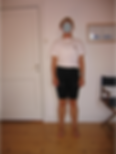Case Study
An integral question we explore when assessing an individual’s acute and chronic musculoskeletal issues is:
Are your pains, injuries, and movement restrictions due to the specific sites of dysfunction or might there be a reason for each that’s connected?
Let's explore a case study below to understand how we:
-
Correlate ones health history and posture to his/her issues.
-
Use the body's innate tools to create and ingrain new patterns for long-term health.

Health History
-
Thirty-Seven Year-Old Female
-
Right Knee – Medial Meniscus Tear - Two Years Ago
•No acute injury; started hurting out of nowhere
-
Left Leg – ITB Syndrome
-
Right Shoulder – Biceps Tendonitis
-
Lower Back: L4-L5 Disc herniation – Last Year
-
Neck: Chronic Tension
-
Occasional Headaches
-
Marathoner (most recent – five years ago). Still runs moderately.
-
Stay at home mom
Let’s make sense of her pains, injuries, and issues:
A powerful tool in understanding how one’s posture might contribute to his or her issues is putting your body in that alignment. You can carefully move around (ie. walk, bend down, raise your arms) from that position. “Form Predicts Function” – a person’s dynamic posture (movement) will be a reflection of static alignment.
Take a Look


Analysis: Initial Snapshot Front and Back Views:
It appears the client has more compensation in her right knee (caving in; valgus stress), shifting her body weight onto the left leg.
Her right arm rotates forward more than the left (increasing the compensation in that shoulder joint).
Take a Look


Analysis: Initial Snapshot Side Views
Her lower legs push back from the ankle and upper legs shift forward. While the client’s pelvis appears horizontal relative to the floor, if we measure its angle relative to the points above and below - hip and lower back - her pelvis is in flexion (tilting back). The person’s upper body is behind the hips, collapsing onto her lumbar spine (crushing those discs), shoulders shift and round back, and head moves forward from shoulders.
Deeper Analysis: Correlating Posture to Pain
My goal for you is to be able to think critically about how ingrained postural patterns can create pain. An effective way to do this is to move up to the pictures after reading each paragraph below. Take time to process the connection and ask yourself if you're seeing and understanding it.
Due the misalignment in the patient’s right knee, each time she takes a step, she’s compressing the meniscus/ligaments on the outside of that knee, and overlengthening them on its inside. This can result in a shearing/tearing of the meniscus or ligaments. Additionally, the bones begin rubbing into each other and starts to push into the cartilage, leading to bone-on-bone with no protective support (arthritis).
The fact that this person is shifting her body weight onto her left leg (to protect her right side) may lead to overusing the muscles on the outside of the left leg, potentially resulting in an overuse injury such as ITB (Iliotibial Band) Syndrome; especially as she’s a runner. We ideally want the body to distribute weight evenly left to right.
Look at the position of her right hand relative to the left; you can see more of the back her right hand. It’s likely a result of her arm rotated in from the shoulder (as a function of her shoulder blade winging out, a response to the position of her pelvis). Try lifting your arm straight in front of you with it in this position compared to doing so based upon the position of her left arm. Doesn’t it make sense that she has a right shoulder injury?!
The individual’s upper body has shifted back behind her hips. Simply get into this position yourself. Are you feeling how this compresses the discs in your lower back? Over time, if one’s upper body is collapsing onto the lower back, the discs might wear out and herniate, as there is compression with each movement.
In order to prevent her upper body from following the spine and falling backwards, she counterbalances her head forward (now in front of her body). While this is a good temporary solution, it may create the neck tension she’s experiencing. Try it for yourself: Push your hips forward, upper back rounded, and head forward. How does this feel on your neck? Her neck muscles might be overworking as a means of preventing her head (10-14 lbs.) from falling forwards. These tense neck muscles connect into her head; the added constant tension here often results in headaches.
How Might We Approach Helping Her Body?
On a very basic level, the first thing that we’ll want to do is to align her body from the side. Doing this often allows chronically tight muscles to release and lays the foundation for the deeper postural muscles to begin working. An exercise as simple as the Static Back Position can have profound effects in ‘loading’ the body from the side.

*Have your palms up, arms between shoulder & hip height
The objective is to begin the process of taking her from the example of the model’s (below) posture on the left to that on the right.

The next step is to address her joint mechanics, such as her right arm rotated in, pelvis flexed back, and knee having valgus stress (caving in).
In relation to the model’s posture, our aim is to change the position of her pelvis from that on the right (below) to the nice, neutral pelvis on the left.

An exercise like the Kneeling Groin Stretch can help move the pelvis from flexion to a strong extended position....

While a passive exercise as the one below can begin the process of realigning the bones of her leg (which may additionally reset the position of her pelvis and right arm).

*Have your palms up, arms between shoulder & hip height. Feet should be flexed down, not up.
If all we were to do is realign her bones, that would only help temporarily. She’d likely soon default back to ingrained postural patterns she’s held for months, years....even decades! In order for the bones to stay in the right position, we’ll want to give her body the stimulus to engage her deep postural line of muscles and connective tissue to keep her body aligned.
Exercises such as a Kneeling Table Top Stretch and Standing Arm Circles are powerful ones to accomplish this goal.

Both exercises have the effect of creating extension (opening) in the spine, resetting the position of the arms, shoulder blades, and pelvis AND engaging the deep postural line to maintain these adaptations subconsciously. As your body adjusts this way, you're also creating natural space for your internal organs to function more optimally.

The goal is to help her feel and move better. This is accomplished as we:
1. Put the bones in the right position.
2. Engage the deep postural muscles to keep her body aligned – in both static and dynamic posture.
3. Based upon her health history, posture and gait, determine which of the over 500 Postural Therapy Exercises (ranging from completely passive to highly active) are specific to meeting the goals above.
4. Provide the client with an individualized Postural Therapy Sequence to do consistently and correctly in order to reinforce these natural and optimal postural patterns.
5. Having movement feel as effortless, efficient, controlled and energetic as possible!



